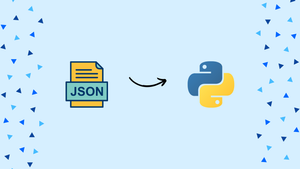Introduction
Before we begin talking about how to parse and process JSON Data in Python, let's briefly understand – What is JSON data?
JSON data, or JavaScript Object Notation, is a lightweight and popular data interchange format. It is easy for humans to read and write, and for machines to parse and generate. JSON organizes data into key-value pairs, making it ideal for storing and transferring structured information.
It is widely used in web development, APIs, and data storage due to its simplicity and compatibility with various programming languages. Understanding JSON is crucial for developers and anyone working with web-based technologies to handle data efficiently and effectively.
In this tutorial, you will learn how to parse and process JSON Data in Python.
Advantages of JSON Data in Python
- Simplified Data Handling: Parsing and processing JSON data in Python simplifies data handling by providing built-in methods to load, read, and manipulate JSON objects effortlessly.
- Language Compatibility: Python's extensive JSON support allows seamless integration with other programming languages, making it easy to exchange data across different platforms.
- Web API Interaction: Python's JSON capabilities enable effortless interaction with web APIs, facilitating data retrieval and integration from various online sources.
- Efficient Data Transformation: Python's JSON modules enable efficient data transformation, enabling developers to convert JSON data into Python objects and vice versa effortlessly.
- Error Handling: Python's JSON libraries offer robust error handling mechanisms, ensuring smooth and reliable JSON data processing with detailed error reporting and exception handling.
The following table shows the equivalent JSON representation of Python objects:
| Python | JSON |
|---|---|
| dict | object |
| list, tuple | array |
| str | string |
| int, float | number |
| True | true |
| False | false |
| None | null |
Encoding JSON in Python
Python objects can be encoded into JSON-formatted strings using either the dump() or dumps() methods, provided by the json module.
The output is sent to a file-like object by the dump() method. The two positional arguments accepted are the object to be encoded and the file-like object. Here's an example:
data = {
"country": "Germany",
"vehicle": {
"name": "Volkswagen",
"model": "T-Roc"
}
}
with open("file.json", "w") as file:
json.dump(data, file)
It will generate a file named file.json when you run the script.
{"country": "Germany", "vehicle": {"name": "Volkswagen", "model": "T-Roc"}}
The dumps() method is identical to dump(), except that it returns a string instead of writing the output to a file-like object.
data = {
"country": "Germany",
"vehicle": {
"name": "Volkswagen",
"model": "T-Roc"
}
}
json.dumps(data)
Output
'{"country": "Germany", "vehicle": {"name": "Volkswagen", "model": "T-Roc"}}'
Both methods accept the same keyword arguments. For example, you can specify the indentation level when analyzing or debugging JSON data.
data = {
"country": "Germany",
"vehicle": {
"name": "Volkswagen",
"model": "T-Roc"
}
}
print(json.dumps(data, indent=2))
Output
{
"country": "Germany",
"vehicle": {
"name": "Volkswagen",
"model": "T-Roc"
}
}
Decoding JSON in Python
Use the load() and loads() functions to convert JSON-encoded data into Python objects.
The load() function converts a JSON structure into a Python object by reading it from a file-like object.
Say we have the JSON file shown below:
[
{
"userId": 1,
"id": 1,
"title": "Meet with Lisa",
"completed": true
},
{
"userId": 1,
"id": 2,
"title": "Design a prototype",
"completed": false
}
]
You could use something like this to turn JSON data into a Python representation.
import json
with open('file.json') as f:
data = json.load(f)
type(data)
The JSON is converted into a Python list, which can then be used in your code:
Output
<class 'list'>
A string storing a JSON document is transformed into a Python object using the loads() method:
import json
json_str= '{"userId": "1", "id": "1", "title": "Meet with Lisa", "completed": "True"}'
print(json.loads(json_str))
To create a Python dictionary, transform the string.
Output
{'userId': '1', 'id': '1', 'title': 'Meet with Lisa', 'completed': 'True'}
Here is a more complex illustration of how to use an API and decode JSON data:
import json
import requests
response = requests.get("https://jsonplaceholder.typicode.com/users")
users = json.loads(response.text)
print(users)
FAQs to Parse and Process JSON Data in Python
How do I load JSON data from a file in Python?
In Python, you can use the json.load() function to load JSON data from a file. This function reads the JSON file and returns a Python object representing the data.
Can I convert JSON data into Python objects?
Yes, Python's "json" module provides the json.loads() function to convert JSON data into Python objects like dictionaries and lists.
How can I access specific values in a JSON object in Python?
You can access values in a JSON object in Python by using the key names as you would with a dictionary. For example, obj['key'] will give you the value associated with 'key'.
Can Python handle nested JSON data?
Yes, Python can handle nested JSON data. You can access nested values by chaining the keys together, like obj['key1']['key2'].
How can I handle errors when parsing JSON data in Python?
Python's json module provides error handling through exceptions. You can use try-except blocks to catch and handle JSON-related errors, such as json.JSONDecodeError.
Is Python suitable for processing large JSON datasets?
Yes, Python is capable of handling large JSON datasets efficiently. You can use streaming techniques or libraries like ijson to process large JSON files in a memory-friendly manner.
Conclusion
In this tutorial, you parsed and processed JSON Data in Python.
If you have any queries or doubts, please leave them in the comment below. We'll be happy to address them.
